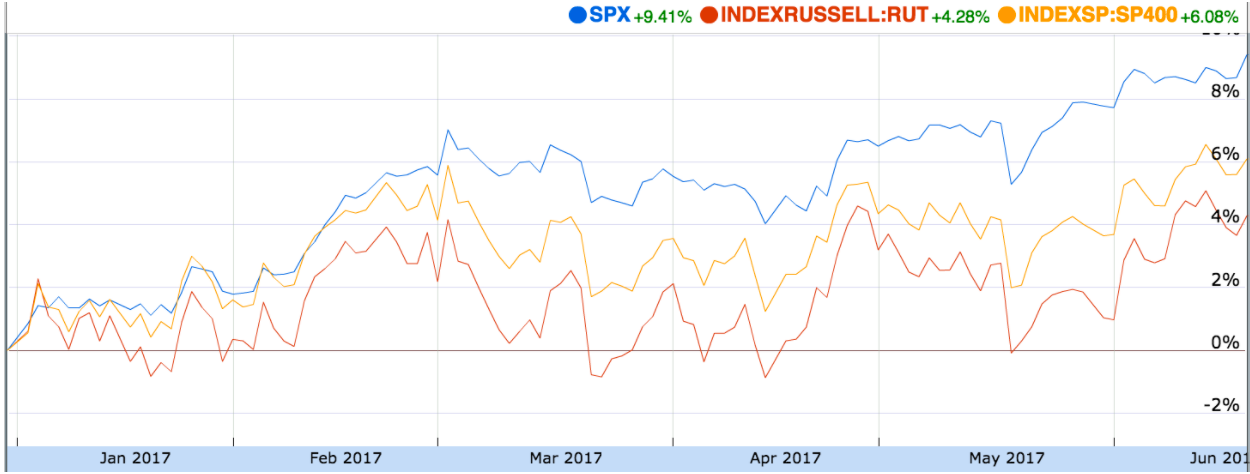Have you heard? The market’s in a bit of an uptrend as of late. The major averages—Dow Jones, S&P 500, and Nasdaq Composite—are all at or near all-time highs.
Depending on whom you ask, the reason for this rally varies. It could be a continued reaction to the election of Donald Trump, and the market hoping he’ll accomplish his agenda. Or maybe it’s because of the Federal Reserve, which just raised rates for the third time since 2015. It could even be due to an interplanetary alignment.
Regardless of why the market is in rally mode, investors aren’t complaining—especially large-cap investors. The S&P 500 is up 9.5 percent since January 1, 2017. That’s 50 percent more than the S&P Midcap 400 (up 6.12 percent) and more than double the small-cap Russell 2000 (up 4.23 percent).
The period has also been a boon for large-cap ETFs, such as the O'Shares FTSE U.S. Quality Dividend ETF OUSA, as investors have scrambled to diversify across the asset class.
OUSA invests in large-cap dividend stocks, and investors have added over $42 million in assets to the fund this year alone. This recent inflow of investment has been a common theme for large-cap ETFs during this rally, as funds like the PowerShares S&P 500 Hgh Qlty Prtfl ETF SPHQ and the Vanguard Mega Cap ETF MGC have seen similar buying activity in 2017.
In case you’re not on the buying train right now, here are five reasons you may want to consider adding to your large-cap exposure right now.

Data shown from 1/1/2017-6/19/2017. S&P500 (SPX) vs Russell 2000 vs S&P MidCap 400
Minimize the impact of volatility
We’re clearly operating in a low volatility environment. With the volatility index at all-time lows, some investors may want to consider the impact that an—even slightly—more volatile environment could have on their portfolio. In the world of equity investing, large-cap stocks are historically more immune to spikes in volatility than their low-and mid-cap counterparts.
The last time the CBOE Volatility Index rose above 16, in November 2016, the S&P 500 fell about 3.2 percent, while the S&P 400 fell nearly 3.7 percent and the Russell 2000 fell 6.5 percent.
They Often Pay Dividends
Large-cap stocks typically operate diversified businesses in established industries, which leads to strong cash flows. With all that cash, it’s common for stocks to pay out dividends to their investors as an incentive for holding the stock.
Dividends are essentially a second income stream for investors on top of any capital gains. Large-cap dividend stocks are considered safe havens, though still have substantial risks, for investors because they may provide income even when stocks aren’t appreciating in value. Stocks like Pfizer Inc. PFE, Philip Morris International Inc. PM, and Procter & Gamble Co PG have historically offered dividends yields of at least 3 percent.
Large-Cap Stocks Are Dominating The Market
In early June, a note from Goldman Sachs temporarily sent the tech sector spiraling by comparing today’s largest tech companies—Facebook Inc FB, Amazon.com, Inc. AMZN, Apple Inc AAPL, Microsoft Corporation MSFT and Alphabet Inc GOOG GOOGL—to the dotcom bubble.
While the comparison isn’t quite apt (valuation ratios aren’t nearly as high as they were in the early 2000’s), the underlying sentiment is a common one: the market is driven by large-cap stocks. Those five stocks alone added over $660 billion in market cap in the first half of 2017.
As these tickers continue to drive higher, investors hoping to get in on outsized returns are piling into large-cap stocks.
Large-Cap Stocks Are Historically More Resistant To Downturns
While no investment is immune from drawdowns, few asset classes have shown historical resilience like large-cap stocks; especially for equity investors. The sheer size of these companies is enough to allow them to potentially overcome near-term headwinds, such as a shift in the business cycle or an economic downturn. These companies tend not to carry a lot of debt—at least compared to many small-and mid-cap stocks—and are therefore less exposed to catastrophic balance sheet events.
Strong Earnings Growth
Earnings for the S&P 500 is estimated to have grown by 6.5 percent in the second quarter of 2017, according to data from FactSet. This marks the third quarter in a row that large-cap stocks have posted positive earnings growth, a sharp shift away from the previous trend of seven straight quarters of negative earnings growth dating back to March 2015.
Of course, past performance does not equal future results, but the first half of 2017 made large-cap investors some of the happiest on Wall Street.
Or, to shortcut the arduous process of stock picking, investors can examine any number of large-cap stock ETFs, like any of the ETFs mentioned above.
Edge Rankings
Price Trend
© 2025 Benzinga.com. Benzinga does not provide investment advice. All rights reserved.
Trade confidently with insights and alerts from analyst ratings, free reports and breaking news that affects the stocks you care about.